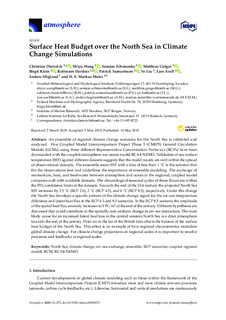| dc.description.abstract | An ensemble of regional climate change scenarios for the North Sea is validated and analyzed. Five Coupled Model Intercomparison Project Phase 5 (CMIP5) General Circulation Models (GCMs) using three different Representative Concentration Pathways (RCPs) have been downscaled with the coupled atmosphere–ice–ocean model RCA4-NEMO. Validation of sea surface temperature (SST) against different datasets suggests that the model results are well within the spread of observational datasets. The ensemble mean SST with a bias of less than 1 ∘ C is the solution that fits the observations best and underlines the importance of ensemble modeling. The exchange of momentum, heat, and freshwater between atmosphere and ocean in the regional, coupled model compares well with available datasets. The climatological seasonal cycles of these fluxes are within the 95% confidence limits of the datasets. Towards the end of the 21st century the projected North Sea SST increases by 1.5 ∘ C (RCP 2.6), 2 ∘ C (RCP 4.5), and 4 ∘ C (RCP 8.5), respectively. Under this change the North Sea develops a specific pattern of the climate change signal for the air–sea temperature difference and latent heat flux in the RCP 4.5 and 8.5 scenarios. In the RCP 8.5 scenario the amplitude of the spatial heat flux anomaly increases to 5 W/m 2 at the end of the century. Different hypotheses are discussed that could contribute to the spatially non-uniform change in air–sea interaction. The most likely cause for an increased latent heat loss in the central western North Sea is a drier atmosphere towards the end of the century. Drier air in the lee of the British Isles affects the balance of the surface heat budget of the North Sea. This effect is an example of how regional characteristics modulate global climate change. For climate change projections on regional scales it is important to resolve processes and feedbacks at regional scales. | nb_NO |
